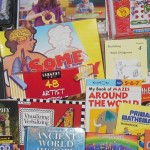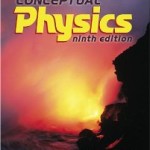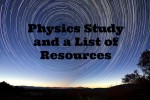This year we are continuing with CPO Physical, Earth, and Space Science. This thick book will take us awhile to get through. We started it towards the end of last school year and we are continuing it this year. However, it is only part of our science studies since we are also spending time learning about invertebrates.
CPO labs are designed to be used with expensive lab equipment. As a result, I’m adapting and substituting with more inexpensive labs when appropriate. I’ve also added many creative science challenges.
The 5th grader loves science so we are using a hefty book to help feed his hunger. I tried approaching physical science without a textbook, but my knowledge base wasn’t strong enough to pull that off so we are using a textbook. My 3rd grader is a highly creative visual-spatial learner. He will be reading the books I’ve listed for him. When he is done with reading he will have time to do projects on ideas he learned in the books or related to other science questions he has.
Because I know we won’t finish the book this year, I’ve only mapped out through chapter 10. The CPO text has 28 chapters in total. It is supposed to take an entire school year to complete if you spend 4-5 45 minute class periods each week. We aren’t doing that. We are spending a total of 4 hours per week on science, but it isn’t just on this textbook.
3.1 Position, Coordinates, and Maps
Investigation 3A: Positive and Negative Position (5th and 3rd grader)
Read pg 51-59 and complete pg 60 (5th grader)
Check for Understanding (5th grader)
Skill and Practice Worksheet 3.1 Latitude and Longitude (5th grader)
Map and Compass by Jacobson (3rd grader)
3.2 Topographic Maps
Investigation 3B: Topographic Mapping (5th grader and 3rd grader)
Read pg 61-64 and complete pg 65
Check for Understanding
Skill and Practice Worksheet 3.2 Topographic Maps
Egg Drop Contest (all kids)
Container must be no larger than 12x12x12 inches, no parachutes
Dropped from second floor of house to cement patio.
3.3 Bathymetric Maps
Read pg 66-68 and complete pg 69 (5th grader)
Check for Understanding (5th grader)
Skill and Practice Worksheet 3.3 Bathymetric Maps (5th grader)
Skill and Practice Worksheet 3.3 Tanya Atwater Biography (5th grader)
Complete chapter 3 Assessment pg 70-73 (5th grader)
Tracking Trash Flotsam, Jetsam, and the Science of Ocean Motion – Burns (3rd grader)
4.1 Speed and Velocity
Read pages 74-79 and complete pg 80 (5th grader)Check for understanding with me (5th grader)
Skill and Practice Worksheet Speed (5th grader)
Skill and Practice Worksheet Vectors on a Map (5th grader)
Skill and Practice Worksheet Velocity (5th grader)
Speed and Acceleration by Somervill (3rd grader)
Speed and Acceleration by Spilsbury (3rd grader)
Balloon Blast-Off
Balloon blast-off http://pbskids.org/zoom/ activities/sci/balloonblastoff.html
Balloon Blast-Off
4.2 Graphs of Motion
Investigation 4A – Use hot wheels track and car the distance traveled by the car. Time is the amount of time it took for the car to travel to that spot. Position is the distance away from the start. Calculate speed for 6 different points on the track.
Read pages 81-84 and complete pg 85 (5th grader)
Check for understanding with me (5th grader)
Skill and Practice Worksheet – Analyzing Graphs of Motion with Numbers (5th grader)
DK Car Science – Hammond (3rd grader)
4.3 Acceleration
Investigation 4B – Acceleration (5th grader and 3rd grader)
Use hot wheels track again and lab to figure acceleration of the hot wheels car.
Bill Nye Motion (5th grader and 3rd grader)
Read pg 86-92 and complete page 93 (5th grader)
Check for understanding with me (5th grader)
Skill and Practice Worksheet Acceleration (5th grader)
Complete chapter 4 assessment pg 94-96 (5th grader)
Marvelous Machines Rides at Work (3rd grader)
The Biggest Thrill Rides by Mitchell (3rd grader)
High-Speed Thrills Acceleration and Velocity (3rd grader)
Ping-Pong Fling
Ping-Pong Fling Sciencewise 2 pg 155
5.1 Forces
Investigation 5A: What is a Newton?
http://www.explorelearning.com /index.cfm?method=cResource.dspDetail &ResourceID=653 (sign up for free trial – copy and paste and remove the spaces)
Use this tool to complete the investigation – just use pumpkin and other items instead of washers. Measure on Earth, the moon, and other planets. (3rd grader and 5th grader)
Read pg 97-105 and complete page 106 (5th grader)
Check for understanding with me (5th grader)
Skill and Practice Mass vs. Weight (5th grader)
Energy, Forces, and Motion Usborne (3rd grader)
Forces and Motion by Gardner (3rd grader)
Forces and Movement – Riley (3rd grader)
5.2 Friction
Investigation 5B Force and Fan Activity sheet and online http://www.explorelearning.com /index.cfm?method=cResource.dsp Detail&ResourceID=614 (5th grader and 3rd grader)
Read pg 107-112 and complete page 113 (5th grader)
Check for understanding with me (5th grader)
Skill and Practice Friction (5th grader)
Experiments with Friction by Tocci (3rd grader)
Friction and Resistance – Oxlade (3rd grader)
Bill Nye – Friction (5th grader and 3rd grader)
Racing Blimps
5.3 Forces and Equilibrium
6.1 Newton’s First Law
Bungee Jump
6.2 Newton’s Second Law
Read pg 130-134 and complete pg 135 (5th grader)
6.3 Newton’s Third Law and Momentum
Read pg 136-142 and complete pg 143 (5th grader)
Marble Raceway Challenge
7.1 Force, Work, and Machines
7.2: Energy and the Conservation of Energy
Read pages 155-165 and complete pg 166 (5th grader)
Door opener
7.3 Efficiency and Power
8.1 The Nature of Matter
Water Filter
8.2 Temperature
8.3 The Phases of Matter
Read pages 190-194 and complete page 195 (5th grader)
The Leaning Tower
9.1 Heat and Thermal Energy
9.2 Heat Transfer
Rube Goldberg Invention
10.1 Density
Read page 216-220 and complete page 221 (5th grader)
10.2 Properties of a Solid
Puff Mobile
10.3 Properties of Fluids
10.4 Buoyancy





